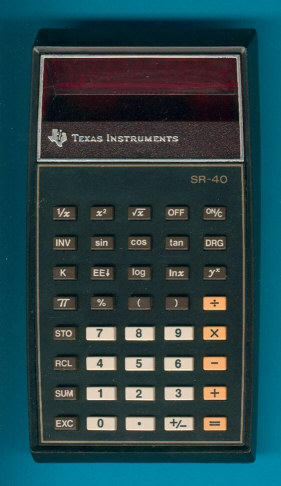
DATAMATH CALCULATOR MUSEUM
 |
DATAMATH CALCULATOR MUSEUM |
Texas Instruments SR-40
| Date of introduction: | June 13, 1976 | Display technology: | LED-stick |
| New price: | $49.95, £26.95 | Display size: | 8 (5 + 2) |
| Size: | 5.8" x 3.1" x
1.4" 148 x 78 x 36 mm3 |
||
| Weight: | 4.0 ounces, 114 grams | Serial No: | 2200153 |
| Batteries: | BP5, BP8 | Date of manufacture: | wk 50 year 1976 |
| AC-Adapter: | AC9131, AC9132 | Origin of manufacture: | USA |
| Precision: | 10 | Integrated circuits: | TMC0981 |
| Logic: | AOS - 4 Pending Operations, 15 () | ||
| Memories: | 1 | ||
| Program steps: | Courtesy of: | Joerg Woerner | |
| Download leaflet: | |
Download manual: | |
 The
SR-40 was introduced mid of 1976 together with the entry calculator TI-30
and the financial calculator Business Analyst.
These three calculators defined a new manufacturing approach within Texas
Instruments. Everything is snapped together, not a single screw is used within
the whole
calculator. Compared with the earlier SR-50A
or SR-16-II
and even the failed SR-40 Prototype calculators, the electronics was squeezed dramatically.
The preceding calculators used a main printed circuit board (PCB) and a small
daughter board carrying the display.
The
SR-40 was introduced mid of 1976 together with the entry calculator TI-30
and the financial calculator Business Analyst.
These three calculators defined a new manufacturing approach within Texas
Instruments. Everything is snapped together, not a single screw is used within
the whole
calculator. Compared with the earlier SR-50A
or SR-16-II
and even the failed SR-40 Prototype calculators, the electronics was squeezed dramatically.
The preceding calculators used a main printed circuit board (PCB) and a small
daughter board carrying the display.
 The SR-40 and all
other (except the SR-51-II and TI-45) calculators in the Majestic-line used a LED-stick carrying the whole
electronics! If you dismantle such a calculator you'll find the LED-stick, one
resistor and one integrated circuit in a 28 pin housing. The electronics of
the SR-40 is centered around a TMC0981 circuit, a member of the
TMC0980
single-chip calculator family, while the TI-45 uses a chip from the
TMC1980
family. Both designs are based
on the TMS1000 Microcomputer
series with an increased memory capacity of 18,432 Bits Read-Only Memory (ROM, 2k*9 Bits) and 576 Bits Random-Access Memory (RAM, 9 Registers * 16 digits). Main differences between the TMC0980 and TMC1980 are the display
drivers - while the former supports LED displays, adds the latter high-voltage
drivers for Vacuum Fluorescent Displays (VFD). In addition includes the TMC1980 both an integrated charge pump driver to generate the high voltage (around -22V) for the Anodes and Grids of the VF-Display and integrated drivers for the Filament (heater)
allowing for reasonable manufacturing costs.
The SR-40 and all
other (except the SR-51-II and TI-45) calculators in the Majestic-line used a LED-stick carrying the whole
electronics! If you dismantle such a calculator you'll find the LED-stick, one
resistor and one integrated circuit in a 28 pin housing. The electronics of
the SR-40 is centered around a TMC0981 circuit, a member of the
TMC0980
single-chip calculator family, while the TI-45 uses a chip from the
TMC1980
family. Both designs are based
on the TMS1000 Microcomputer
series with an increased memory capacity of 18,432 Bits Read-Only Memory (ROM, 2k*9 Bits) and 576 Bits Random-Access Memory (RAM, 9 Registers * 16 digits). Main differences between the TMC0980 and TMC1980 are the display
drivers - while the former supports LED displays, adds the latter high-voltage
drivers for Vacuum Fluorescent Displays (VFD). In addition includes the TMC1980 both an integrated charge pump driver to generate the high voltage (around -22V) for the Anodes and Grids of the VF-Display and integrated drivers for the Filament (heater)
allowing for reasonable manufacturing costs.
If you are interested in the calculating accuracy of scientific calculators don't miss the Calculator forensics.
If we discover the sources of the components used in this SR-40 we locate:
| The LED chips were furnished by the SC Group in Dallas. The lens by an Ohio supplier. The circuit board and the IC are from TI Singapore. The board assembly was by TI Taiwan. The keyboard was made at TI Lubbock and assembled to the board in the Lubbock or Abilene plant. |
Within the Majestic-line you'll find two base architectures with only small differences:
The entry line uses a 9-digit LED-stick giving either 8 digits display in normal mode or 5+2 digits in scientific mode. The calculators uses ON/OFF keys.
Simply by comparing the designation of the integrated circuits of the entry line "Majestic" calculators, you'll get the all members of this family:
|
TMC0980
Goulds
Pumpulator uses a custom design ROM (CD9801) Digging deeper into the TMC098x calculator chips you'll locate an OEM-chip used on a TI-30 "clone" manufactured in Hong Kong: TMC0985 Amelia Scientific 2001 |
Texas Instruments introduced the revolutionary Algebraic Operating System (AOS) in September 1975 with their flagship Programmable calculator SR-52 but this SR-40 and its sibling TI-30 brought it to the masses. And consequently created a nightmare for TI's Portfolio Manager of Scientific calculators...
Later in production of the Majestic-line calculators the metallized TI logo was changed to lower manufacturing costs. View here the SR-40 w/o chrome.
AOS is a trademark of Texas Instruments.
If you have additions to the above article please email: joerg@datamath.org.
© Joerg Woerner, December 5, 2001. No reprints without written permission.